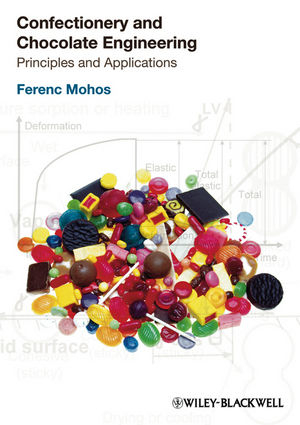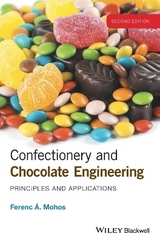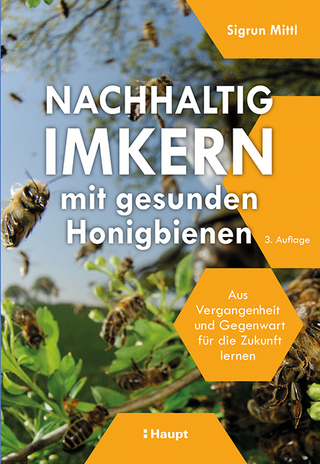
Confectionery and Chocolate Engineering
Wiley-Blackwell (an imprint of John Wiley & Sons Ltd) (Verlag)
978-1-4051-9470-9 (ISBN)
- Titel ist leider vergriffen;
keine Neuauflage - Artikel merken
Confectionery and chocolate manufacture has been dominated by large-scale industrial processing for several decades. It is often the case, though, that a trial and error approach is applied to the development of new products and processes, rather than verified scientific principles. The purpose of this book is to describe the features of unit operations used in confectionary manufacturing. In contrast to the common technology-focused approach to this subject, this volume offers a scientific, theoretical account of confectionery manufacture, building on the scientific background of chemical engineering. The large diversity of both raw materials and end products in the confectionery industry makes it beneficial to approach the subject in this way. The industry deals with a variety of vegetable based raw materials as well as milk products, eggs, gelatin, and other animal-based raw materials. A study of confectionery and chocolate engineering must therefore examine the physical and chemical, as well as the biochemical and microbiological properties of the processed materials.
By characterizing the unit operations of confectionery manufacture the author, who has over 40 years' experience in confectionery manufacture, aims to open up new possibilities for improvement relating to increased efficiency of operations, the use of new materials, and new applications for traditional raw materials. The book is aimed at food engineers, scientists, technologists in research and industry, as well as graduate students on relevant food and chemical engineering-related courses.
Professor Ferenc Mohos is Managing Director of Food Quality 1992 Ltd, Budapest, Hungary
Preface. Acknowledgements. Part I Theoretical introduction. Chapter 1 Principles of food engineering. 1.1 Introduction. 1.2 The Damkohler equations. 1.3 Investigation of the Damkohler equations by means ofsimilarity theory. 1.4 Analogies. 1.5 Dimensional analysis. 1.6 The Buckingham theorem. Further reading. Chapter 2 Characterization of substances used in theconfectionery industry. 2.1 Qualitative characterization of substances. 2.2 Quantitative characterization of confectionery products. 2.3 Preparation of recipes. Chapter 3 Engineering properties of foods. 3.1 Introduction. 3.2 Density. 3.3 Fundamental functions of thermodynamics. 3.4 Latent heat and heat of reaction. 3.5 Thermal conductivity. 3.6 Thermal diffusivity and Prandtl number. 3.7 Mass diffusivity and Schmidt number. 3.8 Dielectric properties. 3.9 Electrical conductivity. 3.10 Infrared absorption properties. 3.11 Physical characteristics of food powders. Chapter 4 The rheology of foods and sweets. 4.1 Rheology: its importance in the confectionery industry. 4.2 Stress and strain. 4.3 Solid behaviour. 4.4 Fluid behaviour. 4.5 Viscosity of solutions. 4.6 Viscosity of emulsions. 4.7 Viscosity of suspensions. 4.8 Rheological properties of gels. 4.9 Rheological properties of sweets. 4.10 Rheological properties of wheat fl our doughs. Chapter 5 Introduction to food colloids. 5.1 The colloidal state. 5.2 Formation of colloids. 5.3 Properties of macromolecular colloids. 5.4 Properties of colloids of association. 5.5 Properties of interfaces. 5.6 Electrical properties of interfaces. 5.7 Theory of colloidal stability: the DLVO theory. 5.8 Stability and changes of colloids and coarsedispersions. 5.9 Emulsion instability. 5.10 Phase inversion. 5.11 Foams. Part II Physical operations. Chapter 6 Comminution. 6.1 Changes during size reduction. 6.2 Rittinger's 'surface' theory. 6.3 Kick's 'volume' theory. 6.4 The third, or Bond, theory. 6.5 Energy requirement for comminution. 6.6 Particle size distribution of ground products. 6.7 Particle size distributions. 6.8 Kinetics of grinding. 6.9 Comminution by fi ve-roll refi ners. 6.10 Grinding by a melangeur. 6.11 Comminution by a stirred ball mill. Chapter 7 Mixing/kneading. 7.1 Technical solutions to the problem of mixing. 7.2 Power characteristics of a stirrer. 7.3 Mixing-time characteristics of a stirrer. 7.4 Representative shear rate and viscosity for mixing. 7.5 Calculation of the Reynolds number for mixing. 7.6 Mixing of powders. 7.7 Mixing of fl uids of high viscosity. 7.8 Effect of impeller speed on heat and mass transfer. 7.9 Mixing by blade mixers. 7.10 Mixing rolls. 7.11 Mixing of two liquids. Chapter 8 Solutions. 8.1 Preparation of aqueous solutions of carbohydrates. 8.2 Solubility of sucrose in water. 8.3 Aqueous solutions of sucrose and glucose syrup. 8.4 Aqueous sucrose solutions containing invert sugar. 8.5 Solubility of sucrose in the presence of starch syrup andinvert sugar. 8.6 Rate of dissolution. Chapter 9 Evaporation. 9.1 Theoretical background Raoult's law. 9.2 Boiling point of sucrose/water solutions at atmosphericpressure. 9.3 Application of a modifi cation of Raoult s law tocalculate the boiling point of carbohydrate/water solutions atdecreased pressure. 9.4 Vapour pressure formulae for carbohydrate/watersolutions. 9.5 Practical tests for controlling the boiling points ofsucrose solutions. 9.6 Modelling of an industrial cooking process for chewycandy. Chapter 10 Crystallization. 10.1 Introduction. 10.2 Crystallization from solution. 10.3 Crystallization from melts. 10.4 Crystal size distributions. 10.5 Batch crystallization. 10.6 Isothermal and non-isothermal recrystallization. 10.7 Methods for studying the supermolecular structure of fatmelts. 10.8 Crystallization of glycerol esters: Polymorphism. 10.9 Crystallization of cocoa butter. 10.10 Crystallization of fat masses. 10.11 Crystallization of confectionery fats with a hightrans-fat portion. 10.12 Modelling of chocolate cooling processes andtempering. Chapter 11 Gelling, emulsifying, stabilizing and foamformation. 11.1 Hydrocolloids used in confectionery. 11.2 Agar. 11.3 Alginates. 11.4 Carrageenans. 11.5 Furcellaran. 11.6 Gum arabic. 11.7 Gum tragacanth. 11.8 Guaran gum. 11.9 Locust bean gum. 11.10 Pectin. 11.11 Starch. 11.12 Xanthan gum. 11.13 Gelatin. 11.14 Egg proteins. 11.15 Foam formation. Chapter 12 Transport. 12.1 Types of transport. 12.2 Calculation of flow rate of non-Newtonian fluids. 12.3 Transporting dessert masses in long pipes. 12.4 Changes in pipe direction. 12.5 Laminar unsteady flow. 12.6 Transport of flour and sugar by air flow. Chapter 13 Pressing. 13.1 Applications of pressing in the confectionery industry. 13.2 Theory of pressing. 13.3 Cocoa liquor pressing. Chapter 14 Extrusion. 14.1 Flow through a converging die. 14.2 Feeders used for shaping confectionery pastes. 14.3 Extrusion cooking. 14.4 Roller extrusion. Chapter 15 Particle agglomeration: Instantization andtabletting. 15.1 Theoretical background. 15.2 Processes of agglomeration. 15.3 Granulation by fl uidization. 15.4 Tabletting. Part III Chemical and complex operations: Stability ofsweets. Chapter 16 Chemical operations (inversion andcaramelization), ripening and complex operations. 16.1 Inversion. 16.2 Caramelization. 16.3 Alkalization of cocoa material. 16.4 Ripening. 16.5 Complex operations. Chapter 17 Water activity, shelf life and storage. 17.1 Water activity. 17.2 Shelf life and storage. 17.3 Storage scheduling. Chapter 18 Stability of food systems. 18.1 Common use of the concept of food stability. 18.2 Stability theories: types of stability. 18.3 Shelf life as a case of marginal stability. 18.4 Stability matrix of a food system. Part IV Appendices. Appendix 1 Data on engineering properties of materials usedand made by the confectionery industry. A1.1 Carbohydrates. A1.2 Oils and fats. A1.3 Raw materials, semi-fi nished products and fi nishedproducts. Appendix 2 Solutions of sucrose, corn syrup and othermonosaccharides and disaccharides. Appendix 3 Survey of fl uid models. A3.1 Decomposition method for calculation of fl ow rate ofrheological models. A3.2 Calculation of the friction coeffi cient ofnon-Newtonian fl uids in the laminar region. A3.3 Generalization of the Casson model. A3.4 Determination of the exponent n of the flow curve ofa generalized Casson fluid. A3.5 Dependence of shear rate on the exponent n in thecase of a generalized Casson fluid. A3.6 Calculation of the fl ow rate for a generalized Cassonfluid. A3.7 Lemma on the exponent in the generalized Cassonequation. Appendix 4 Fractals. A4.1 Irregular forms fractal geometry. A4.2 Box-counting dimension. A4.3 Particle-counting method. A4.4 Fractal backbone dimension. Appendix 5 Introduction to structure theory. A5.1 General features of structure theory. A5.2 Attributes and structure: A qualitative description. A5.3 Hierarchical structures. A5.4 Structure of measures: A quantitative description. A5.5 Equations of conservation and balance. A5.6 Algebraic structure of chemical changes. A5.7 The technological triangle: External technologicalstructure. A5.8 Conserved substantial fragments. Appendix 6 Technological lay-outs. Further reading. References. Index.
| Erscheint lt. Verlag | 20.8.2010 |
|---|---|
| Zusatzinfo | Illustrations |
| Verlagsort | Chicester |
| Sprache | englisch |
| Maße | 181 x 249 mm |
| Gewicht | 1516 g |
| Einbandart | gebunden |
| Themenwelt | Technik |
| Weitere Fachgebiete ► Land- / Forstwirtschaft / Fischerei | |
| ISBN-10 | 1-4051-9470-7 / 1405194707 |
| ISBN-13 | 978-1-4051-9470-9 / 9781405194709 |
| Zustand | Neuware |
| Haben Sie eine Frage zum Produkt? |
aus dem Bereich



